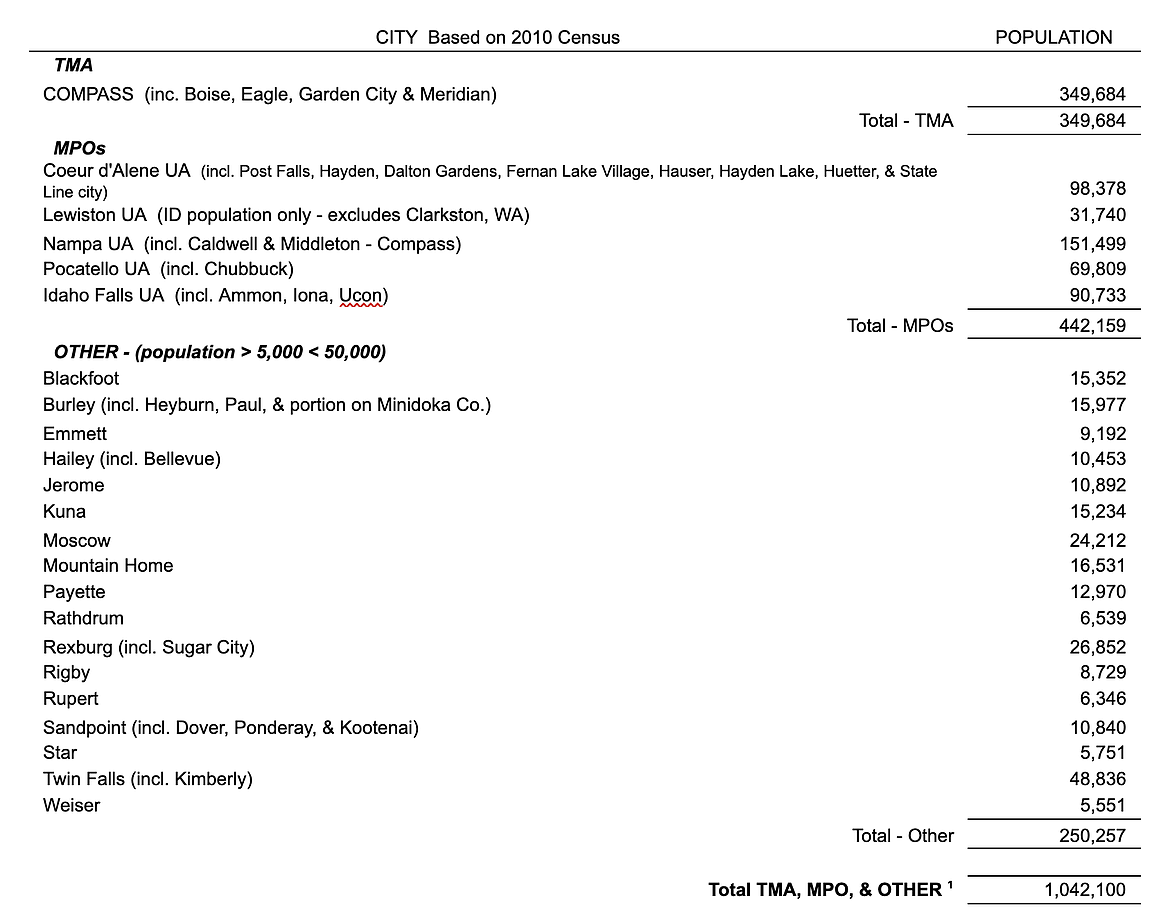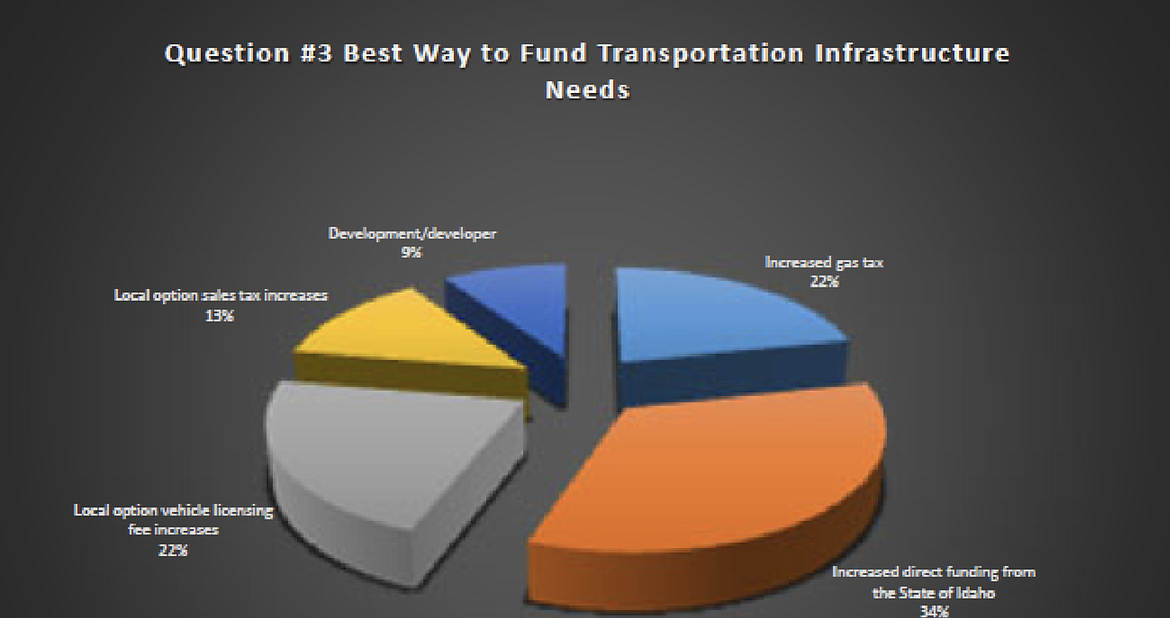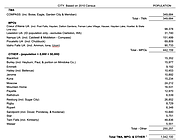Analysis: Solving growth and transportation funding disparities
About six months ago the Post Falls Chamber of Commerce surveyed its business members regarding the impact of growth on our transportation system. A majority of those responding to the survey indicated that increased traffic had impacted their businesses in many ways, ranging from delays in the receipt and shipment of goods and services, to increased commute times for their employees, to increases in the cost of business services involving transportation.
NOTE: The Idaho Transportation Department operates and maintains the State Highway System consisting of more than 12,200 lane miles of roads. Local cities, counties and highway districts operate and maintain the local street and highway system consisting of no less than 55,786 lane miles or 82% of the roads in Idaho.
Source: https://apps.itd.idaho.gov/apps/Fund/Local/SURTYPE12.pdf
NOTE: There are 4,492 bridges in Idaho. Of these, 1,848 bridges are on the state highway system, and 2,375 are local bridges; the remainder are owned and maintained by federal agencies. Therefore 53% of Idaho’s road bridges are owned and maintained by cities, counties and highway districts.
Source: IDAHO'S - Infrastructure Report Card www.infrastructurereportcard.org
Interestingly, the vast majority of our transportation funding comes from the Legislature through the Idaho Transportation Department (ITD). Presently ITD receives 60% of State gas tax revenues, while local cities, counties and highway districts receive only 40%, which is divided between the 199 cities, 44 counties and 63 local highway districts.
One can argue that ITD roads are more heavily used and should have higher levels of services, such as frequent snowplowing; however, Post Falls and Coeur d’Alene have streets with traffic volumes greater than many state highways, and are also used by the same people using the state highways.
The Idaho Legislature is currently considering an allocation of Supplemental Transportation Funding from the State General Fund Surplus. While still before the Legislature, it appears that 70% of the Idaho Sales Tax Supplement would go to ITD, with only 30% to local entities.
The majority of those transportation dollars are allocated for state highways and — although those highways pass through many rural areas, very few — if any — of the ITD annual allocation formulas take rate of GROWTH and population increases into consideration.
A perfect example of this lack of ITD oversight is the COVID Stimulus Bill, which Congress passed last December. That stimulus bill provided the State of Idaho with nearly $71 Million in unanticipated transportation funding.
Statewide Boise Urbanized Area Total Statewide
Population 349,684
Idaho $66,976,862 $3,974,863 $70,951,725
Source: FHWA Notice - FY 2021 - N4510.851 - Highway Infrastructure Program COVID....pdf
With virtually no oversight or concern by our Legislature, these funds have been allocated in the following way: Of the total of $71 Million:
• The Boise Metropolitan Area will receive $3.97 Million because it is over 200,000 population. Based on a population of 349,684 people.
• $4.5 Million is available to the five remaining metropolitan areas of Coeur d’Alene, Lewiston, Nampa/Caldwell, Pocatello, and Idaho Falls; as well as 17 communities with populations of between 5,000 and 50,000.
This means only $4.5 million will be distributed to areas that represent 693,416 people, while the Boise area alone, receives $3.97 million for 349,684 people. This happens because the ITD Board, by its own policy, chooses to keep more of the money provided by Congress for ITD’s own use.
The balance of the federal COVID Relief funds of December 2020- $62.8 Million (88.5% of the total funds) has been allocated by the ITD Board to itself, ITD.
Clearly, the allocation of those stimulus funds did not take population, growth, or road miles into consideration. The combined population of the five metropolitan planning areas is 26% higher than that of Boise, even before you add the population of the 17 other communities lumped into that allocation base. ITD uses the same formula each year as Congress approves the annual appropriations bill. Now you see why very little funding is available for improving our local and regional transportation system.
It is time for the governor and the members of the Legislature to establish some oversight parameters for the manner in which Idaho’s transportation funding is allocated. ITD clearly needs to be required to recognize population, growth and urban road miles, as key factors in its funding allocation decisions.
We all need to remember that it is our state’s growing urban areas that provide the majority of the State’s tax revenues and population that drives federal transportation funding to the State of Idaho. Those areas need to receive more realistic proportional funding for transportation investments.
I hear a lot about how growth should help pay for improving our roads and streets in Kootenai County. Well, until the transportation funding allocation formulas are updated to reflect local transportation investment need, and the Legislature provides some allocation guidelines to ITD, that is simply NOT going to happen.





